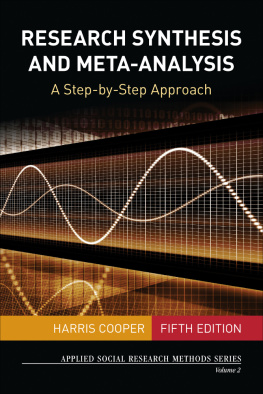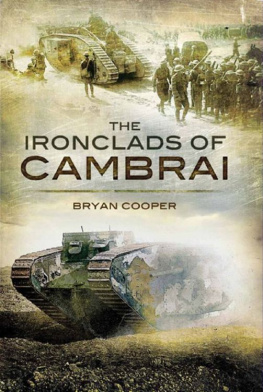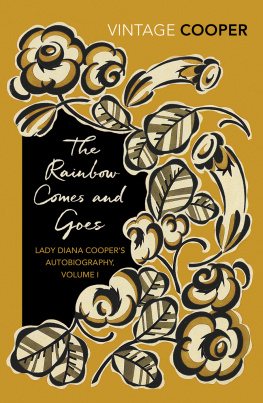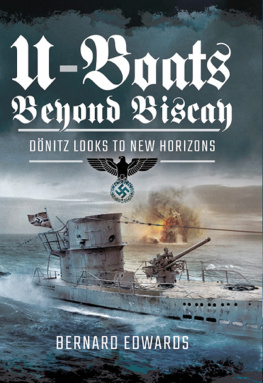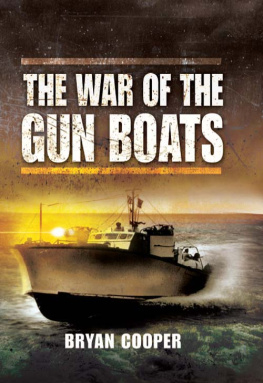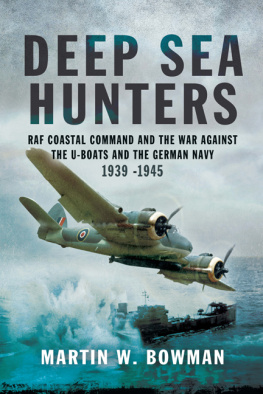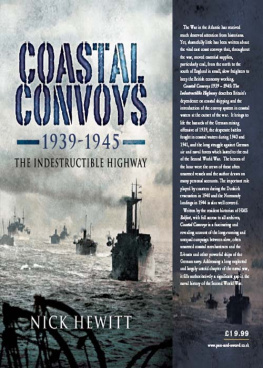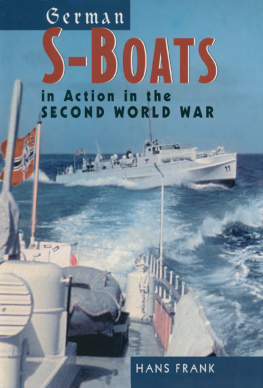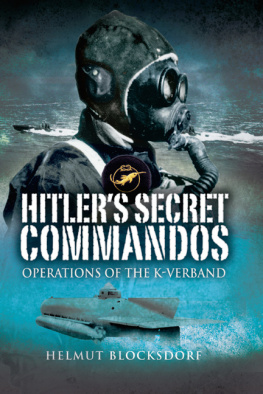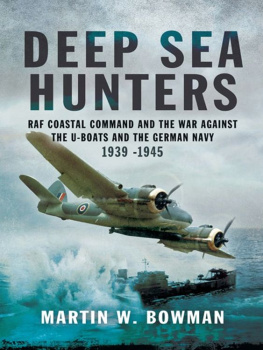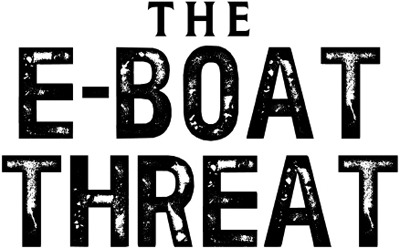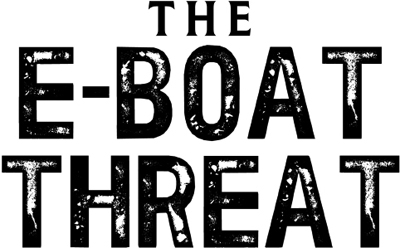Other books by Bryan Cooper
The Ironclads of Cambrai*
North Sea Oil The Great Gamble
Battle of the Torpedo Boats
The Buccaneers
PT Boats
Alaska The Last Frontier
A History of Fighter Aircraft
A History of Bomber Aircraft
Tank Battles of WWI*
The Adventure of North Sea Oil
The War of the Gunboats*
-------------------
NOVELS
Stones of Evil
The Wildcatters
*Denotes titles in print with Pen & Sword Books Ltd
Bryan Cooper
Pen & Sword
MARITIME
First published in Great Britain in 1976 by Macdonald and Janes Publishers Limited
Reprinted in this format in 2015 by
PEN &SWORD MARITIME
An imprint of
Pen & Sword Books Ltd
47 Church Street
Barnsley, South Yorkshire
S70 2AS
Copyright Bryan Cooper, 1976, 2015
ISBN 978 1 47382 783 7
The right of Bryan Cooper to be identified as Author of this work has been asserted by him in accordance with the Copyright, Designs and Patents Act 1988.
A CIP catalogue record for this book is available from the British Library
All rights reserved. No part of this book may be reproduced or transmitted in any form or by any means, electronic or mechanical including photocopying, recording or by any information storage and retrieval system, without permission from the Publisher in writing.
All the photographs are from The Imperial War Museum, with the following exceptions: the photograph on page 6 is from Brian L. Davis, that on page 62 is from Drppel and those on pages 78 and 80 are from Beken of Cowes.
Drawings and Diagrams by Peter Endsleigh Castle AMRAeS
Printed and bound in England
By CPI Group (UK) Ltd, Croydon, CR0 4YY
Pen & Sword Books Ltd incorporates the Imprints of Aviation, Atlas, Family History, Fiction, Maritime, Military, Discovery, Politics, History, Archaeology, Select, Wharncliffe Local History, Wharncliffe True Crime, Military Classics, Wharncliffe Transport, Leo Cooper, The Praetorian Press, Remember When, Seaforth Publishing and Frontline Publishing
For a complete list of Pen & Sword titles please contact
PEN & SWORD BOOKS LIMITED
47 Church Street, Barnsley, South Yorkshire, S70 2AS, England
E-mail: enquiries@pen-and-sword.co.uk Website: www.pen-and-sword.co.uk
CONTENTS
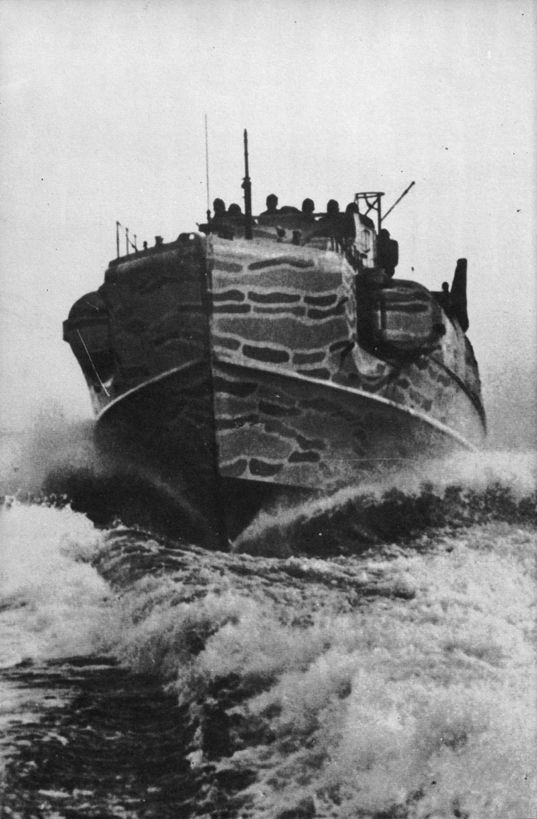
Camouflaged E-boatreturning tobase after an operational sortie
All the major powers that fought in World War II, with the exception of Japan, built large numbers of motor torpedo boats specifically to operate in coastal waters. These highly manoeuvrable little ships, when they met in action, were involved in some of the closest-fought sea battles of the war. But their main function was to attack much larger enemy vessels, either merchant shipping or warships, by using the striking power of their torpedoes.
The main advantages of motor torpedo boats were their size and speed. They were small enough to move largely unseen at night, with sufficiently shallow draught to pass safely over enemy minefields. They were fast enough, with speeds of 40 knots and more, either to roar up on enemy ships to attack them broadside or, what was often preferable, to make a rapid escape after creeping up slowly and quietly on the enemy. Once their torpedoes had been fired, the little ships needed speed to get away before the enemys guns could be brought to bear on them. One further advantage was that such craft could be built relatively cheaply in numerous boatyards, leaving the more specialised shipyards free to concentrate on building warships.
But motor torpedo boats had their disadvantages as well. Because weight of armament had to be sacrificed to speed, they were especially vulnerable to attack by enemy aircraft and this usually limited their operations to the hours of darkness. Because of the high fuel-consumption of their powerful engines, range was limited to a few hundred miles unless auxiliary gasoline tanks were carried. And because of their size and light construction necessary factors in achieving high speeds motor torpedo boats could not operate in very heavy seas. Even in less rough conditions they were prone to mechanical breakdown. Nevertheless, it was extraordinary what a hammering they could take and still survive. The men who crewed these night hunters might curse the buffeting they got, but as they rode the waves with bows lifted and wakes foaming a long trail behind, they knew an exhilaration of speed that no other kind of ship could give.
In spite of the very considerable damage they caused, the motor torpedo boats of all the major navies were too small and numerous to be given the dignity of individual names and were known by numbers instead. To the British they were MTBs (Motor Torpedo Boat), to the Americans PT-boats (Patrol Torpedo), to the Italians MAS-boats (Motoscafo Anti-Sommergibile), and to the Germans S-boats (Schnellboot, meaning fast boat). For some curious and unexplained reason, the Schnellboot was always referred to by the British Navy as an E-boat, presumably standing for Enemy war motorboat. This term could, of course, be applied to many other enemy craft and would have caused only confusion rather than aiding identification. In fact, in all other instances, the British Navy used the initial letter of the actual German word for describing a particular type of craft. Had this been done in the case of motor torpedo boats, they would have been known rightly as S-boats, as they were to the Germans. Several suggestions have been put forward to explain this, including the ingenious theory that the E might have stood for the technical term Lrssen Effekt (one of the features introduced into their boats in the 1930s by the Lrssen shipyard which later became responsible for building most of the German S-boats). It is probable, however, that the real explanation is the simplest and that the E was meant to stand merely for Enemy. Both before and at the beginning of the war, these craft (whether British or German) were not taken very seriously by the Admiralty, and it is likely that the definition was rather thoughtlessly coined in the belief that it would seldom be used. Although the Germans also developed motor boats for other purposes, such as the Lrssen R-boats (Rumboot) which were used for minelaying, mine-sweeping and coastal convoy protection when it was armed with 37mm and 20mm guns, these were referred to by their correct prefixes, so that the Royal Navys E-boat designation stood only for motor torpedo boats.
Whatever they were called, motor torpedo boats fought very successfully in the coastal waters of every major theatre of the war in the North Sea and English Channel, the Mediterranean and among the dreamy islands of the Aegean, the Baltic, off Burma and Malaya and in the South China Sea, and across the Pacific to the final liberation of the Philippines. Probably their most wide-scale use was in the Pacific, largely by the United States for the Japanese did less than any other naval power to develop such craft, mainly due to chronic lack of suitable engines. Thus there was nothing comparable to combat the American PT-boats as they took part in the island-hopping strategy to liberate Japanese-occupied territories. PT-boats were used to attack coastal supply ships, they cooperated closely with the US Army during troop landings, and took part in some of the great fleet battles in the Pacific where they were effective in sinking Japanese warships up to the size of light cruiser. The Mediterranean conflict saw the biggest variety of craft. The British, Americans, Germans and Italians used motor torpedo boats both to attack as well as to defend convoys as both sides fought desperately to keep open lines of supply to their land forces. Malta and Sicily featured prominently in this struggle, as bases respectively for British and Axis craft. The large canvas of Mediterranean operations gave considerable scope for the kind of lone role that suited the individualistic temperament of those who served in the little ships. As well as their main purpose of attacking enemy convoys, MTBs and PT-boats took part in commando raids and co-operated with partisans fighting behind enemy lines. Large numbers of Italian MAS-boats played a part in the early stages of the war, since Italy had given more attention than the other powers to the military application of such craft and had the largest number of them. At one point in the war, an American PT-squadron was the only representative of the US Navy in the Mediterranean.




